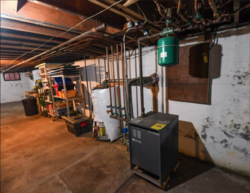Hello all!
Wife and I are finally closing on our new house at the end of this month and we are hustling to get a sweep in to inspect the current wood stove insert as well as the chimney. Currently the propane boiler and wood stove insert are venting out the chimney, which is illegal in NH.
However, we are installing a Pellet Boiler after we close and because both the Boiler and Stove use wood as solid fuel sources, we can once again exhaust both out of the Chimney.
This is where I'm hoping to get some help. I know running one liner out a Chimney is relatively standard but I want to make sure nothing is missed running two liners out for both heating sources.
I'm wondering if there are any specific questions I should ask my sweep when I meet with them on the 28th. THey are well reputed in the area so I think they will do a good job but I know people on this forum are extremely knowledgeable and was wondering if there's anything you'd suggest I discuss with the sweep.
Currently there is a VC WinterWarm in the fireplace and I believe a previous sweep said something on it needed replacing which may be hard considering the age so I'm preparing myself to hear that it is time to replace the stove.
I just want to make the safest, financially sound decision involving this chimney.
Thanks!
Wife and I are finally closing on our new house at the end of this month and we are hustling to get a sweep in to inspect the current wood stove insert as well as the chimney. Currently the propane boiler and wood stove insert are venting out the chimney, which is illegal in NH.
However, we are installing a Pellet Boiler after we close and because both the Boiler and Stove use wood as solid fuel sources, we can once again exhaust both out of the Chimney.
This is where I'm hoping to get some help. I know running one liner out a Chimney is relatively standard but I want to make sure nothing is missed running two liners out for both heating sources.
I'm wondering if there are any specific questions I should ask my sweep when I meet with them on the 28th. THey are well reputed in the area so I think they will do a good job but I know people on this forum are extremely knowledgeable and was wondering if there's anything you'd suggest I discuss with the sweep.
Currently there is a VC WinterWarm in the fireplace and I believe a previous sweep said something on it needed replacing which may be hard considering the age so I'm preparing myself to hear that it is time to replace the stove.
I just want to make the safest, financially sound decision involving this chimney.
Thanks!


